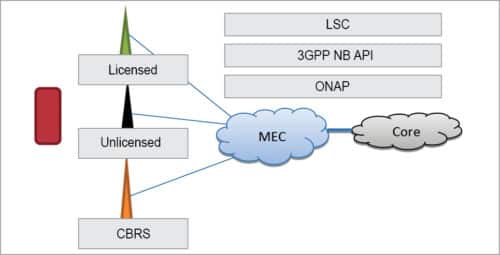Large-scale convergence, or LSC, is not just about the convergence of different technologies. It is about developing a comprehensive framework that will enable delivering of services as per the requirement of various applications.

5G is about many things. And the intrinsic nature of everything is that there will always be scaling up, whether it is in terms of performance KPIs, uses of spectrum, more technology accommodation, operation, management or orchestration. Everything needs to be scaled up, and this is called large-scale convergence, or Large-Scale Convergence (LSC).
5G will soon be all about convergence. It will be defined by it and it will define it too, in addition to new dimensions, large abstractions and so on.
Boingo Wireless’s chief technology officer says, “Beware, convergence is the future! Ubiquitous 5G is not economically practical without coexistence between licensed, unlicensed and shared bands. Mobile connectivity is no longer a device; it is a lifestyle. So, we must embrace converged solutions that leverage multiple bands and technologies.”
5G is also being seen as the catalyst for Industry 4.0—the fourth industrial revolution—which will essentially set the paradigm of Everywhere and Everything Connectivity. The large-scale phenomena will not appear suddenly. It will take multiple approaches to take shape.
To explain how 5G will evolve, let me take the nomenclature from the algorithmic world. It will go through two altogether different approaches, as given below.
- Greedy approach, which focusses on solving specific problems
- Dynamic approach, which is generic in nature and addresses problems with a broader vision
The greedy approach will take place first and will continue with new applications. Early approaches will take footage between 2018 and 2022, like 5G in fixed wireless, LTE-assisted networks.
The dynamic approach will be the real transformation into a complete system of 5G. This is where the concept of LSC comes from. The real period of focus will be from 2020 to 2025.
Large-Scale Convergence is not just about the convergence of different technologies in terms of technical interworking. It is about developing a comprehensive framework that will allow and enable delivering of services as per the requirement of various applications. It is about providing the end users with what they need, based on their requirements and applicability of 5G networks. There was an eminent need for the right platform to create such a framework.
Technologies that will make LSC possible are emerging fast. These are being adopted by ecosystem players across the globe. These technologies provide harmony between ecosystem players and the much-required facilitation for convergence. Some such technologies are discussed next.

Open Network Automation Platform (ONAP)
This is an open source software platform that delivers capabilities for design, creation, orchestration, monitoring and life-cycle management of virtual network functions (VNFs), carrier-scale software-defined networks (SDNs) and higher-level services that combine the above.
Being under the ownership of Linux Foundation and originally ECOMP from AT&T, ONAP provides automatic, policy-driven interaction of these functions and services in a dynamic, real-time cloud environment. It is not just a run-time platform; it includes graphical design tools for function/service creation.
ONAP essentially provides harmonised development, service orchestration and continuous life-cycle management.
VNFs
VNFs and SDNs bring the required adoptability. The need is for a right framework for their harmonisation and interoperability. A well-orchestrated network can cater to large-scale abstraction from application demand. Hence, vendors should take care of this while developing VNFs and SDNs.
Multi-access Edge Computing (MEC)
This is the kingpin in the facilitation of LSC. In fact, MEC will be defined through that as well. Basically, VNFs and MEC will act as a suit for the upcoming 5G architecture.
MEC brings application-specific affinity in 5G, which will be an application-defined network. This application-specific affinity is important for LSC.
Also, end-to-end virtualisation is required for economical as well as political reasons. It is also a factor for defining and placing MEC.
3GPP north-bound APIs
A north-bound API is an interface between an application server and 3rd Generation Partnership Project (3GPP) system via specified functions in a mobile operator’s network. To realise standardised integration of services with diverse service providers, north-bound APIs provide for interaction at the application layer. This makes it possible for mobile network operators to offer a wide range of services beyond prevalent teleservices such as voice calls, SMS and data service. These services can be exposed within the operator network or to third parties in other networks.

Standardisation of north-bound APIs is already there in 3GPP release 14. eMBMS Delivery of Media and TV Services feature provides broadcasters with the ability to directly integrate their services with mobile network operators over standardised interfaces to the 3GPP system.
In release 15, 3GPP will include the functionality to directly expose Cellular IoT and massive machine-type communication (MTC) capabilities via north-bound APIs.
3GPP is also working for a common API framework (FS_CAPIF), focussing on common aspects of north-bound APIs. It is paying attention mainly to architectural aspects such as registration, discovery and identity management, which generally apply to all services. Common API framework functions can be achieved uniformly for such capabilities as service API discovery, monitoring and charging.
FS_CAPIF takes into account both the ongoing work within 3GPP as well as frameworks defined by other organisations. It aims to provide recommendations for specific architectural solutions that can subsequently be standardised.
Saurabh Verma is founder-director and chief technology consultant, Fundarc Communication (xgnlab).










